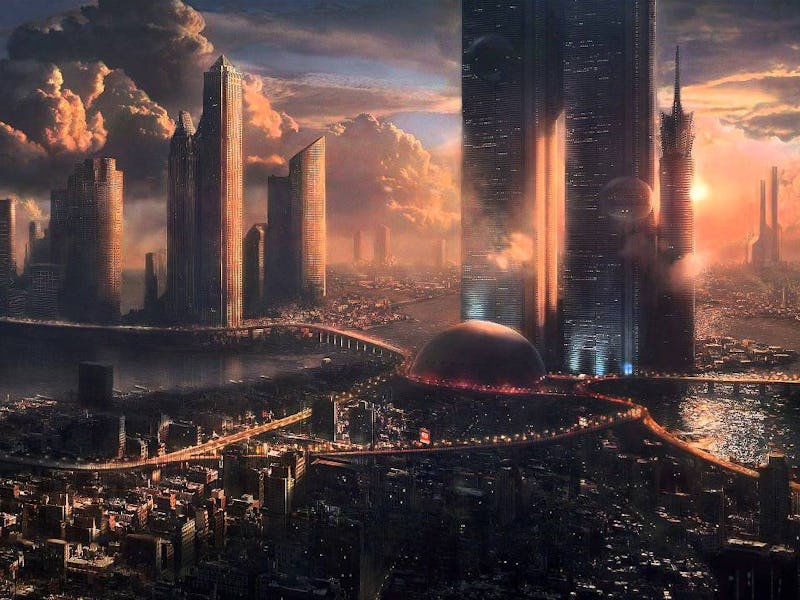No one can accurately predict what Mars is going to look like as the rest of the century unfolds. We just know humans are going to make it to the red planet — and the plan is to stick around and make a new home for ourselves.
When it comes to making predictions about the future, few are in better shape to correctly anticipate what’s next than Michio Kaku. The famed theoretical physicist already has an idea of what Mars is going to transform into soon enough.
“If you take a look at a timeline, we’re talking about the 2030s before we have the first basic settlements on Mars,” Kaku tells Inverse. He’s talking primarily about NASA’s and SpaceX’s goal to have regular crewed trips to Mars occurring during that decade. Meanwhile, NASA is aiming for a 2033 deadline for sending humans to the red planet, while SpaceX may succeed in as little as seven or eight years.
Those settlements are going to be bare bones habitats — structures meant to provide life support systems that enable astronauts to live for several months at a time, but nothing that you could really call self-sustaining. It’s going to take a lot of time and hard work to get to that point. Thankfully, we’re going to have a big cadre of robots to help build everything and provide much-needed manufacturing and construction support.
But, “By 2050, 2060,” says Kaku, “we’re beginning to have not just a few astronauts but a little colony — a beginning of a colony.” These communities, or series of small communities, will probably have mastered a few of the necessities that will make living on Mars sustainable and largely independent of Earthly resources. We’ll probably see bigger greenhouses developed to grow fruits and vegetables for hungry colonists. Energy infrastructure will be up and running, as well as water treatment and recycling facilities. Communications equipment may finally be advance enough to send faster transmissions between Mars and Earth.
In order for a colony on Mars to truly be sustainable, it will probably need about 160 inhabitants. That’s enough hands to help run things, but not too many mouths to feed and provide oxygen for.
And finally, “by the end of the century,” says Kaku, “perhaps the first [large-scale] settlements … if Elon Musk has his way, he wants a fleet of 1,000 Falcon Heavy rockets, each one with 100 passengers each, to create the first cities on Mars, perhaps early in the next century.”
Kaku is referring to SpaceX’s plan to send 100 to 200 people to Mars on a single ship. After 1,000 trips made over the course of 40 to 100 years, the company hopes to have sent over one million pool to Mars in order to help establish a real, major Martian city. Perhaps that city will be the one the United Arab Emirates wants to finish building by 2117.
“After a certain point, these colonies become self-sufficient,” says Kaku. “They’ll have mining operations. They’ll be able to create their own infrastructure. They won’t need a life support from the planet Earth. They’ll be able to create wealth, and then, if they harvest asteroids, they’ll be able to even make money doing this. Think about that. Platinum inside the asteroids could be valued up to hundreds of billions of dollars per small asteroid. That would help to pay for itself, to create an infrastructure on Mars.”
That sounds like an incredible feat, but as retired Canadian astronaut Chris Hadfield also tells Inverse, it’s really not unthinkable when you take a look at the history of Earth.
“I think if you look at Antarctica,” says Hadfield, “the first people to ever even sight it were in the early 1800s. The first person to the south pole was in the early 1900s. About 50 years later, we started settling Antarctica, and now thousands of people live on that content. Almost 100 of us live, in the wintertime, at the south pole — the most remote and maybe one of the most technologically difficult places on Earth to live.”
“That has all happened over the same sort of timescale that Michio’s talking about,” he points out, “and it’s all because of discovery, invention, exploration, application and technology, and then using that new place to add to our overall understanding of the world. That’s an evolution that has already happened, that you just need to flip forward to predict the future of a place like Mars.”
Indeed, things often happen a lot faster than humans can really anticipate. “Just remember that in 1803,” says Kaku, “when Thomas Jefferson made the Louisiana Purchase, he doubled the size of America. But he thought it would take 1,000 years to complete the colonization of the Louisiana Purchase. What happened? The gold rush happened. People discovered gold in California. 300,000 settlers converged on San Francisco within a matter of a few years. California became a state the year after that. Things accelerated. There could be a new gold rush in outer space.”
